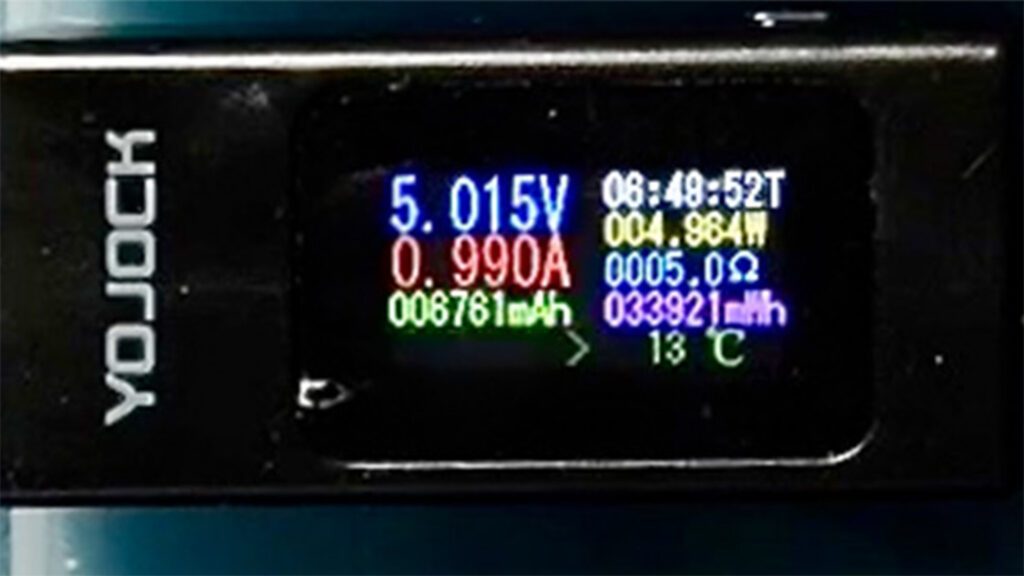Critical Points
Ignore mAh
mAh is what power banks are usually advertised under, and may give you a rough idea of capacity, but it doesn’t tell the whole story. The specification is incomplete as it does not include Voltage.
And mAh listed can be used to hide the true capacity of a battery. Ignore mAh!
Look at Wh (Watt hours)
Instead, look at the Wh (Watt Hour) spec., which will be a better indicator of total power capacity, making it far easier to compare different power banks to each other, then estimate how much you can charge your other electronic devices.
Capacity Loss Affects All Batteries: My 80% Rule of Thumb
Take into consideration that no battery delivers the amount of power spec’d because of inefficiencies throughout your electronics. As a rough way to estimate this, I take 80% of the Wh number from my battery and then compare the Wh capacity of my electronics. 1
And that’s all you need to know! Dive deep down below for the delicious details:
- Critical Points
- Introduction
- USB Power Banks Are Often Mislabeled
- Use Wh Instead
- mAh/1,000 x Voltage = Wh
- Take Into Account Capacity Deprecation From The Loss of Efficiency
- Abide by the Three Rules When Choosing a Power Bank
- Testing Capacity in Power Banks
- What if the Wh on my Power Bank is Not Advertised?
- Comparing Power Banks with Electronics
- Power Bank Charging Estimates of Example Electronics
- Glossary of Terms
- Footnotes
Introduction
For long distance, self-powered trips where I’m trying to optimize everything, the electronics I bring are often in my critical sights. As small as they are, they’re heavy for their volume – especially when compared to other items like clothing.
But electronics can also be extremely useful. My satellite communicator lets loved ones know where I am and allows me to call for help in an emergency. My phone is also my map and navigation system, my music player, my camera, and many other utilities. My head lamp allows me to cover some miles at night. My action video cameras allow me to share my mis-adventures upon an unsuspecting audience.
To keep all these powered, I also bring a small USB power bank. Going overboard on how much power capacity to bring is easy to do (packing your fears!), but bringing too little capacity may mean you won’t have enough power to recharge all of these conveniences we just mentioned.
And believe me: I have been on the side of the road, sun threatening to set, trying to contact someone (anyone!) for a ride from the trailhead to town after many days in the Wilderness, racing the “1% battery” warning on my phone, wondering if my imminent future has me sprawling on a motel bed, devouring a large pizza or if I’m making due with the bitter dregs collected from my leftover food bags, huddled in a fetal position to stave off the cold desert night air relegated to attempting a hitch in the morning.
So, how do you pick out the right power bank size – or at least keep your expectations realistic?
USB Power Banks Are Often Mislabeled
The naive approach – the approach I’ve used myself – is to purchase a lightweight power bank based on the very optically obvious mAh label. mAh is often used as the de-facto specification to market the capacity of a power bank.
For example, a 10,000-mAh sized power bank seems about right for a few days rambling given the rest of what I’m bringing. For example, my phone is spec’d at 3,000mAh, so I can estimate that I should get three full charges out of a 10,000mAh power bank. Easy!
With that out of the way, I can just compare weight of the power bank itself and make my purchase choice on how much each option weighs.
And I would be very wrong.
Why is mAh the Wrong Specification to Look At
Several problems can be pointed out in this approach. One is that mAh is just the wrong specification to look at when comparing two components, since mAh doesn’t tell us the whole story of how much power capacity is in a battery. But it is often used as the most important spec. of a power bank — sometimes with mAh being integrated with the name of the product itself. Observe all these different power banks and their use of mAh in their marketing copy:
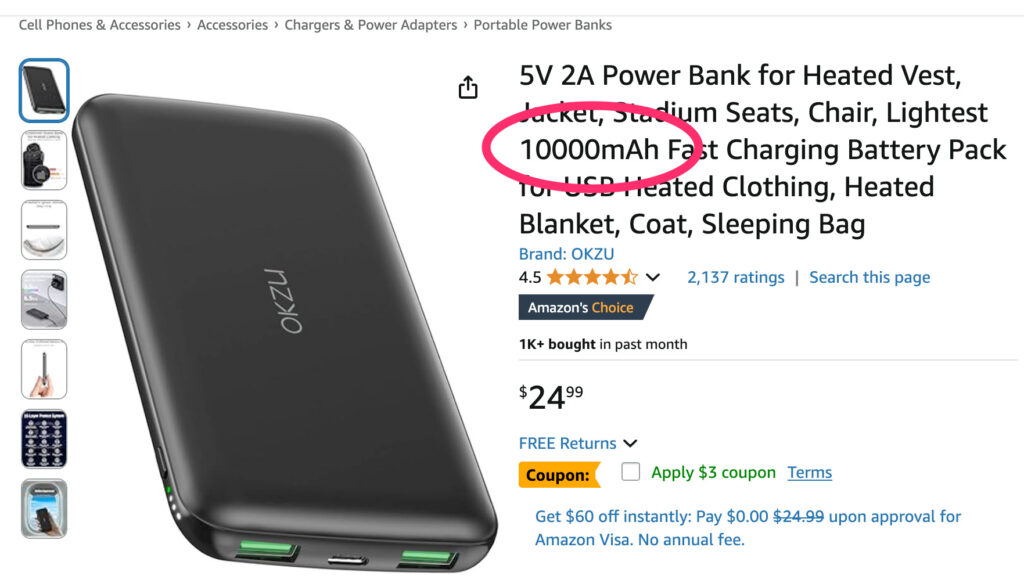
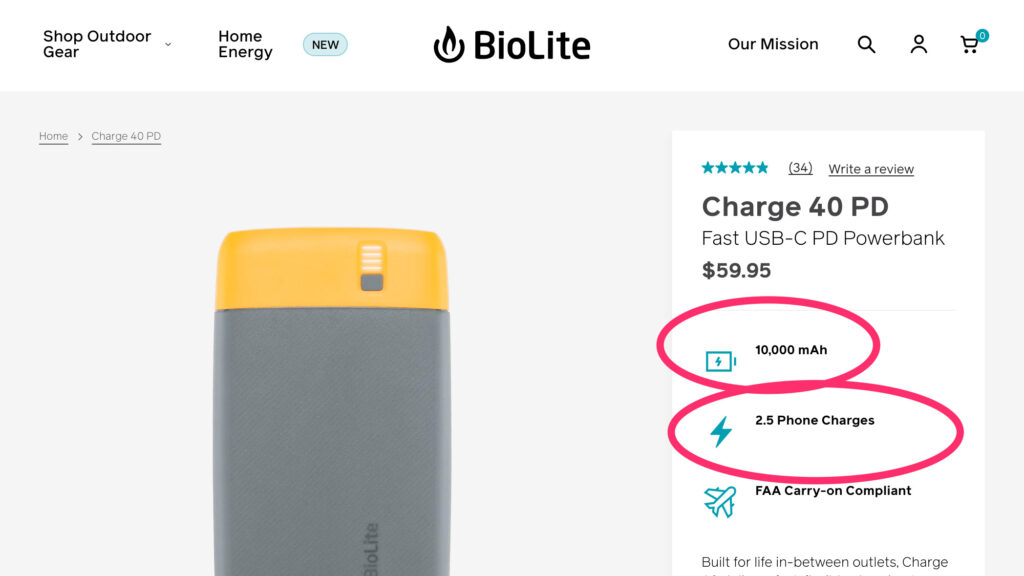
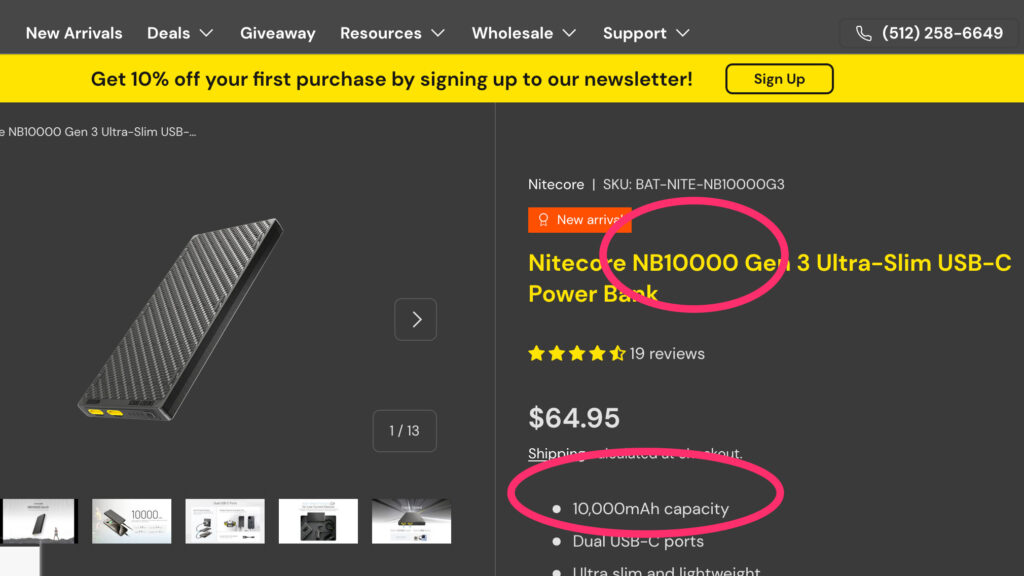

Why is it used? Probably because marketing using a big number is effective.
Use Wh Instead
To be more accurate, we also have to know the battery pack’s native Nominal Voltage. Batteries are chemistry and the voltage they produce varies depending on many different factors, so the average voltage of the battery could also be different between different batteries.
With both mAh and Nominal Voltage, we can get a better idea of the true capacity in Watt Hour (henceforth: Wh) of a power bank. Wh can be found just by multiplying Ah and Voltage2. If you’re lucky, Wh should also be listed in the spec. sheet of the power bank you’re wishing to purchase – check to see if it’s listed on the power bank itself as well. And if you’ve won the Power Bank Truth Lottery, all three of these specifications will line up.
mAh/1,000 x Voltage = Wh
Voltage is often similar on power banks advertised with similar mAh ratings, but small discrepancies add up to big difference in actual, total capacity – and you: the consumer have to be careful. Let’s explore how these small differences impact actual power bank capacity, and how it matters in the long run:
I have two battery packs that I’ll be using to illustrate these concepts. I’ve picked these two because they’re what I have on hand (and full disclosure: that I’ve bought myself at retail), They’re reasonably similar in capacity if we look at mAh and I can test them directly. I originally bought these because they were small, high capacity, and pretty lightweight. Weight – or really: power capacity for the amount of weight I am to carry – is what’s most important to me for light and fast self-powered trips.
The two batteries are the following:
| Power Bank | Listed mAh | Listed Nominal Voltage | Listed Wh | Weight (grams) | Listed Capacity/grams |
|---|---|---|---|---|---|
| GoalZero Flip 36 Gen 5 | 9600 | 3.6 | 35.52 | 194 | .183 Wh/gram |
| Nitecore NB10000 Gen 3 | 10000 | 3.85 | 38.5 | 151 | .254 Wh/gram |
The GoalZero Flip 36 is listed as a slightly smaller capacity battery both in mAh and WH, with a lower nominal voltage compared to the Nitecore NB10000 Gen 3. If we look at just mAh (9600 v 10000) it should have 96% of the capacity.
If we look at Wh, it should have 92.26% the capacity of the NB 10000 Gen3. But strangely, Goal Zero’s own spec sheet doesn’t line up, as 9600mAh x 3.6V does not come to 35.52Wh, but 34.56Wh or 89.8% the capacity of the NB10K Gen3. We’ll keep that in mind, but specifications not lining up could be a red flag. Confusing, but I’ll use 35.52Wh for our discussion.
Now that we have the Wh specifications for our two power banks, how can we approximate how useful they are? For example, how many times will these two charge my phone?
Goal Zero’s own spec. sheet for the Flip 36 does state that it will charge a phone approx. 3x. But phones come in all shapes and sizes, and this is no more than a rough measure. It does coarsely track: my phone’s own battery has a 11.97 Wh capacity, and 35.53 Wh is roughly 3x larger. I could change thrice, and have charge left over!
But,
Take Into Account Capacity Deprecation From The Loss of Efficiency
As I’ve mentioned, this will be incorrect, because we haven’t taken into consideration the loss of power efficiency between the internal battery in the power bank and the phone. This comes in many forms: electrical resistance in the charging cables, loss from heat, as well as loss of efficiency from changing voltage.
That last one needs more explanation: Many electronics – like your phone – charge at 5V, but the nominal voltage of both of these power banks is lower — again: batteries are chemistry, not really a always-available source of electrons. A chemical reaction has to happen to turn the energy into electricity. So, the voltage needs to be normalized and converted to 5V to charge your phone from the power bank.
As a rule of thumb, you can expect a loss of efficiency of your battery pack upwards of 20%. That means our 35.52 Wh battery pack is probably closer to being a 28.4 Wh battery pack, while our 38.5 Wh battery pack is actually a 30.8 battery pack. You may start to see how all these advertised specs. aren’t helping with getting straight answers!
With these new figures, we can see that neither a 28.4 Wh or 30.8Wh power bank will recharge a 11.97 Wh capacity phone battery three times. Instead, we need to temper our expectations. If we really need to charge our phone completely from 0% to 100% three times, we’ll need a larger power bank than either of the power banks I have on hand.
Abide by the Three Rules When Choosing a Power Bank
So, using three rules: ignore mAh, Use Wh, and only trust 80% of capacity, we can make far more informed decisions when buying a power bank, whittling down our choices for what we want, then being able to compare other features (like weight, price).
Testing Capacity in Power Banks
Can we validate the above information? Well, we can substantiate much of this by performing a discharge test on our power banks using an inline USB power meter that shows how many total Wh are being taken out of the power bank, until the power bank stops pushing power out. I’ve done this to our two power banks:
Here are the results:
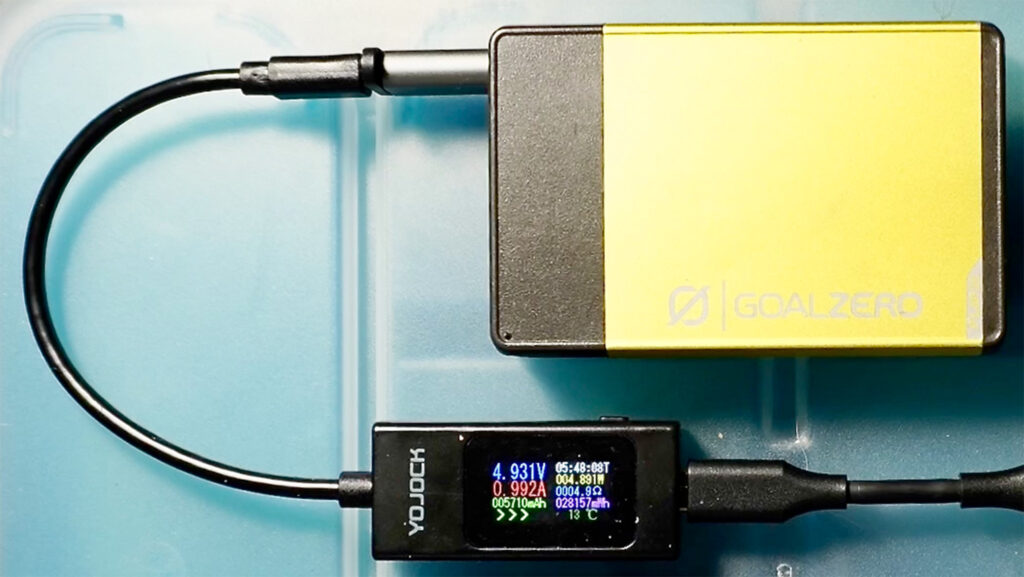
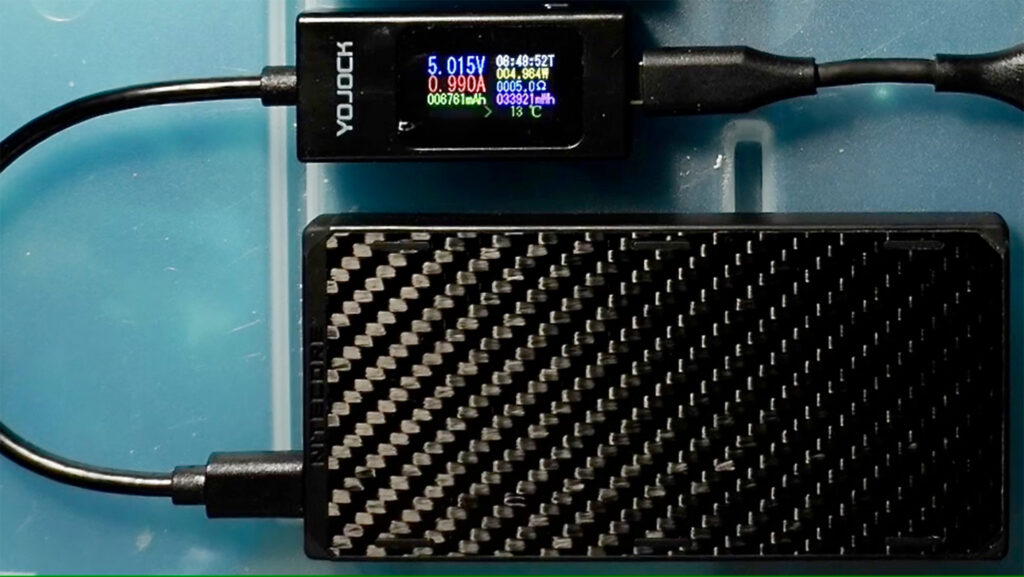
| Battery Pack | Listed Nominal Voltage | Listed mAh | Measured mAh @ 5V | Listed Wh | Measured Wh | Wh Diff |
|---|---|---|---|---|---|---|
| GoalZero Flip 36 | 3.6 | 9600 | 5710 | 35.52 | 28.16 | 79.28% |
| Nitecore NB10000 Gen 3 | 3.85 | 10000 | 6761 | 38.5 | 33.92 | 88.10% |
In our two examples, you’ll note the difference in Actual Wh I recorded and the Listed Wh being advertised. As I stated, we’ll chalk this up to inefficiencies, rather than thinking either manufacturer is misleading us with false advertising and selling us a smaller capacity battery illegitimately (this does happens, but it’s usually pretty easy to spot a counterfeit). And to be clear again: this inefficiency happens to all power banks.
But our test results are suggesting that the inefficiency is different between the two power banks with the GoalZero reporting 79.28% the Wh than it advertises compared to the 88.10% compared to the NiteCore.
This could be explained in a few ways. To be fair (and to be clear, I didn’t start this article to disparage Goal Zero), my Goal Zero is a year older than the NiteCore, and batteries lose capacity over time. 3Another explanation is that the Goal Zero design is really just more inefficient. Internally, it does use 3, 18650 batteries wired up in parallel, whereas the Nite Core uses one battery. I would love to re-do my test with a fresh Goal Zero battery. Another theory is that the NiteCore is actually selling a slightly larger batter than the spec.
Power Capacity to Weight
Since weight – and weight to power capacity – is important to me when choosing a power bank, the NiteCore would be the better pick. With the actual capacity in Wh put into play, the NiteCore now gives me .224 Wh/gram compared to .145 Wh/gram of the Goal Zero. As we’re starting to more clearly see, small differences in advertised specifications become larger differences once we start using these power banks in the real world.
What if the Wh on my Power Bank is Not Advertised?
Most electronics used for backpacking charge at 5V4 and hopefully list at least its mAh, which we can use if all else fails.
Nominal voltage is the general voltage a power bank pushes out before the voltage is stepped up to 5V, so we need to convert our power bank specifications to 5V. This again is why mAh is so tricky to use: since nominal voltage is perhaps different between power banks, actual Wh capacity will also be different even if the mAh spec. is the same – and as we proved above, small differences lead to big differences in actual, measurable capacity.
Here are some formulas to use:
Conversion Formulas
Calculating “Actual” mAh from Advertised mAh
To get the actual usable mAh from the advertised mAh use this:
(Advertised mAh * (Nominal Voltage / 5V )) * Efficiency = Actual mAh.
Then we can compare different electronics using mAh, so long as they are charged at 5V.
For example, we measured the efficiency of our NiteCore at 88.10%, (I use 80% for “Efficiency” when I’m not certain). I know that the nominal voltage of the NiteCore NB10000 Gen3 battery is 3.85V according to its spec sheet, we can fill in everything for mAh:
(10000mAh * (3.85V / 5V)) * .88 = 6776 mAh
This closely matches our test results of 6761 mAh. Only do this if all else fails — stick with Wh to get a better estimate.
Calculating Wh from mAh and Nominal Voltage
As we mentioned, Wh is just mAh multiplied by Nominal Voltage. Then, just multiply this with the efficiency:
((Advertised mAh * Nominal Voltage) / 1000) * Efficiency = Actual Wh
So,
((10000mAh * 3.85) / 1000) * .88 = 33.88 Wh
Which closely matches our measured Wh of 33.92 Wh.
Comparing Power Banks with Electronics
Armed with this information, we can then finally compare electronics against each other. The trick is to compare Watt hours (Wh) only!
For example, the NiteCore Nu20 Classic head lamp has an internal battery specified as at 500 mAh, 3.7V, so we can figure out the Wh as so:
((500 * 3.7) / 1000) = 1.85 Wh
We can take 33.92 Wh and divide it by 1.85 Wh, giving us 18.3x we could recharge this headlamp.
If you don’t know the nominal voltage, use 3.6V for your estimates for lithium ion batteries.
Power Bank Charging Estimates of Example Electronics
Given my own two power banks, here are reasonable estimates on how many times I can charge some of the electronics I use, when using their spec’d Wh or by estimating their Wh given their stated mAh. I added another column to show how this compares to using the naive approach of using mAh, without taking into consideration nominal voltage or inefficiencies:
| Product | mAh | Nominal Voltage | Wh | Naive 1000mAh | With Goal Zero Flip 36 (28.16 Wh) | With NiteCore NB10k Gen3 (33.92 Wh) |
|---|---|---|---|---|---|---|
| iPhone 13 Pro | 3095 | 3.83 | 11.97 | 3.2x | 2.4x | 2.8x |
| Garmin inReach Mini 2 | 1200 | 3.6 | 6 | 8.3x | 4.7x | 5.7x |
| Fenix HM62-T Headlamp | 3400 | 3.6 | 12.24 | 2.9x | 2.8x | 2.3x |
| Black Diamond Distance LT 1100 | 2200 | 3.7 | 8.14 | 4.5x | 3.46x | 4.17x |
| NiteCore NU20 Classic | 500 | 3.7 | 1.85 | 20x | 15.6x | 18.3x |
| GoPro Max Enduro Battery | 1600 | 3.85 | 6.16 | 6.25x | 3.6x | 4.2x |
| Insta360 x4 Battery | 2290 | 3.85 | 8.82 | 4.4x | 2.5x | 3x |
| GoLab Air Pop Earbuds | 350 | 3.6 (estimate) | 1.26 (estimate) | 28.6x | 22.3x | 26.9x |
Here’s a Google Sheet of the above and you can play with the numbers as well.
You can also use your total usable Wh of your power bank as a sort of allowance, and the use of your electronics as taking out from it. If my total allowance is 33.92 Wh, I can start to plan a 4-5 day trip, taking out from my budgeted allowance:
| Product | # Charges | Wh |
|---|---|---|
| iPhone 13 Pro | 2 | 23.94 |
| Garmin inReach Mini 2 | 1 | 6 |
NiteCore NU20 Classic | 1 | 1.85 |
| GoLab Air Pop Earbuds | 1 | 1.26 |
| TOTAL: | 33.05 |
With my one NiteCore NB 10000 Gen3, I’ll have enough capacity to charge the electronics above, with .87 Wh left over.

As you can also see, it’s the phone that’s the most hungry for power, so if you want to further optimize your electronics system, the answer may not be to bring another power bank, but to try to see how you could use your phone in a more mindful way, power-wise.
And that’s how I can more accurately estimate how much power capacity to bring and what to really expect from that power capacity.
Glossary of Terms
I am not an Electrical Engineer, and one of the reasons for me to write about things like power banks is to understand the gear I use a little more closely. Thankfully, the Water Analogy of Electricity has been useful for me as a visual learner who holds an Art Degree in trying to understand concepts that I wasn’t taught in school. Here is how I interpret the concepts:
- Volts: Electrical Potential. The pressure built up of electrons. I imagine this like the water pressure created by a body of water that’s held back by a dam. And with a dam, we can control the amount of water that flows out. If we had a small pipe as the only outlet for water, it would take a long time for all the water to drain out at a controlled rate. But if the dam failed, it would drain out in a stupendous rush, only taking a few minutes. The capacity of that dam is the same (more on that).
- Amps: Unit of measure for electrical current (flow rate). I imagine this similar to the amount of water that can come out of the dam, which is dependent of the size of the pipe coming out. A larger diameter of pipe would allow more flow, but this doesn’t quite tell me how much water has come out, because we don’t know how big my dam is.
- Watts: The rate at which electrical energy is transferred. Watts = Volts x Amps. If my dam was full to the brim (a lot of pressure!), even with a small diameter pipe at the bottom (low amps), water would still come out quite quickly, delivering to me a lot of water. If that pipe had a larger diameter, I could get more water still. But, if the dam’s water pressure was halved, the amount of water coming out of either pipe would be halved too.
- Watt Hours: power in (Watts) over time (Hours). Similar to the total volume of water that we delivered through our pipe. You can think of this as an actual capacity (volume) we measured and then can easily compare between two different containers. If we were able to fill an entire town’s swimming pools with what water was in our dam (leaving it bone dry), we know that the capacity of all the swimming pools and our one dam are equivalent.
- mAh (milliampere hour): power measurement (amp) over time ( hour). This is a problematic measurement. If you look back on my water dam analogy, amps are the size of the pipe, but we have no idea how large the dam (potentiality/pressure) is! Once Volts (potential energy) are known, we then have a good idea of actual capacity, which is what the Watt Hour is.
If you would like to have someone smarter than I, who didn’t fail high school Physics explain this to you, this video was what unlocked the concepts for me the best,
Footnotes
- I wish the Real World wasn’t so full of rough edges, but the “80% Rule” is only a rule of thumb and will vary across different devices and over the lifetime of your power bank, as performance slowly degrades. The math for coming up with this percentage – as is all the math in this article – is going to be hypothetical, just like discussing this in the high school physics class where you probably were introduced to similar concepts. ↩︎
- The writing of this article is a little fast and loose when it talks about doing the math to find Wh from Ampere and Voltage. We’ll convert milliampere to ampere kind of on the fly: 1,000 milliampere = 1 ampere. It’s another one of those head scratchers: why are power banks labeled and marketed using milliampere? 10,000 milliampere is redundant. ↩︎
- Battery capacity will degrade over time, although it’s not so easy to understand at exactly what rate, as it will be due to the varying conditions that you use the power bank in. Using it beyond its stated temperature range for example – as well as and other abuses will most likely have a negative impact on the lifetime and performance of the power bank. ↩︎
- It’s true that not ALL accessories charge at 5V. Some electronics are intelligent enough to negotiate a different voltage power delivery (PD). Just another reason to use Wh, rather than mAh! Using a high voltage also runs into the risk of being less efficient in the delivery of power – a compromise to getting your electronics charged faster. In the context of backpacking, there may not be too many accessories that will negotiate a higher voltage, save for potentially your phone, but if you’re bringing more power-hungry accessories like portable gaming consoles, double-check their specs. ↩︎
